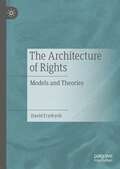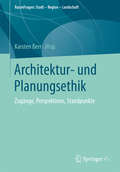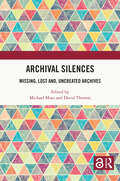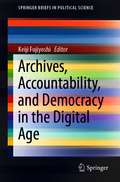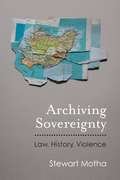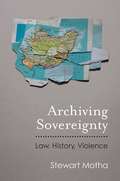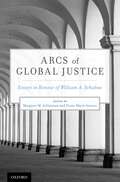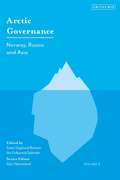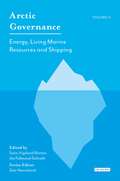- Table View
- List View
The Architecture of Constitutional Amendments: History, Law, Politics
This innovative book blends constitutional theory with real-life political practice to explore the impact of codifying constitutional amendments on the operation of the constitution in relation to democracy, the rule of law, and the separation of powers. It draws from comparative, historical, political and theoretical perspectives to answer questions all constitutional designers should ask themselves:- Should the constitution append amendments sequentially to the end of the text?- Should it embed amendments directly into the existing text, with notations about what has been modified and how? - Should it instead insert amendments into the text without indicating at all that any alteration has occurred? The book examines the 3 major models of amendment codification – the appendative, the integrative, and the invisible models – and also shows how some jurisdictions have innovated alternative forms of amendment codification that combine elements of more than 1 model in a unique hybridisation driven by history, law, and politics.Constitutional designers rarely consider where in the constitution to codify amendments once they are ratified. Yet this choice is pivotal to the operation of any constitution. This groundbreaking book shows why the placement of constitutional amendments goes well beyond mere aesthetics. It influences how and whether a people remembers its past, how the constitutional text will be interpreted and by whom, and whether the constitution will be easily accessible to the governed.A global tour of the high stakes of constitution-making, this book features 18 diverse and outstanding scholars from around the world – across Africa, America, Asia and Oceania, and Europe – raising new questions, opening our eyes to new streams of research, and uncovering new possibilities for constitutional design.
The Architecture of Fundamental Rights in the European Union (Modern Studies in European Law)
by Šejla ImamovicThis book analyses the new architecture for the protection of fundamental rights in Europe after the entry into force of the Lisbon Treaty. As a starting point, it identifies how the EU has gained a prominent role in promoting and protecting fundamental rights at European level despite the absence of an unlimited mandate to address fundamental rights violations. This new setting affects the traditional relationship between the EU, the ECHR system and the Member States and, in the absence of EU accession to the ECHR, enhances the risk of tensions and conflicts between the case law of the two European Courts. Examples of these tensions and conflicts are explored in the Area of Freedom Security and Justice, which is one of the most fundamental rights-sensitive areas of EU law and one of the busiest areas of activity for the CJEU. The book offers new insights into existing rules on the resolution of conflicts between EU and ECHR law before mapping out techniques actually used by domestic courts to avoid or address such conflicts.
The Architecture of Fundamental Rights in the European Union (Modern Studies in European Law)
by Šejla ImamovicThis book analyses the new architecture for the protection of fundamental rights in Europe after the entry into force of the Lisbon Treaty. As a starting point, it identifies how the EU has gained a prominent role in promoting and protecting fundamental rights at European level despite the absence of an unlimited mandate to address fundamental rights violations. This new setting affects the traditional relationship between the EU, the ECHR system and the Member States and, in the absence of EU accession to the ECHR, enhances the risk of tensions and conflicts between the case law of the two European Courts. Examples of these tensions and conflicts are explored in the Area of Freedom Security and Justice, which is one of the most fundamental rights-sensitive areas of EU law and one of the busiest areas of activity for the CJEU. The book offers new insights into existing rules on the resolution of conflicts between EU and ECHR law before mapping out techniques actually used by domestic courts to avoid or address such conflicts.
The Architecture of Rights: Models and Theories
by David FrydrychWhat is a right? What, if anything, makes rights different from other features of the normative world, such as duties, standards, rules, or principles? Do all rights serve some ultimate purpose? In addition to raising these questions, philosophers and jurists have long been aware that different senses of ‘a right’ abound. To help make sense of this diversity, and to address the above questions, they developed two types of accounts of rights: models and theories. This book explicates rights modelling and theorising and scrutinises their methodological underpinnings. It then challenges this framework by showing why the theories ought to be abandoned. In addition to exploring structural concerns, the book also addresses the various ways that rights can be used. It clarifies important differences between rights exercise, enforcement, remedying, and vindication, and identifies forms of legal rights-claiming and rights-invoking outside of institutional contexts.
Architecture’s Disability Problem (Routledge Research in Architecture)
by Wanda Katja LiebermannArchitecture’s Disability Problem explores the intersection of architecture and disability in the United States from the perspective of professional practice. This book uncovers why, despite the profound effect of the Americans with Disabilities Act on the architectural profession, there has been so little interest in design for disability in mainstream architecture. To counter this, the book investigates alternative approaches to designing with disability, through three case studies. These showcase both buildings and how design processes driven by disabled people shape design and professional roles.Combining historical research, formal and discourse analysis, and interviews with people who design, construct, use buildings, and advocate for access, the book develops a social understanding of how the buildings work at functional, affective, and symbolic levels. Architecture’s Disability Problem is aimed at three primary readers: practicing architects, architectural scholars, and members of disability scholar-activist communities. Grounded in detailed design studies, the author hopes to unearth the social meaning-making of architecture related to disability. Ultimately, the book makes an argument for a focus on disability in its own right—as well as on the body—in place of the dominance of formal, object-oriented approaches.This book presents and argues for a fundamental shift in the way architectural education, policy, and practice views and engages with disability. It will be key reading for students, researchers, practitioners and policy-makers.
Architecture’s Disability Problem (Routledge Research in Architecture)
by Wanda Katja LiebermannArchitecture’s Disability Problem explores the intersection of architecture and disability in the United States from the perspective of professional practice. This book uncovers why, despite the profound effect of the Americans with Disabilities Act on the architectural profession, there has been so little interest in design for disability in mainstream architecture. To counter this, the book investigates alternative approaches to designing with disability, through three case studies. These showcase both buildings and how design processes driven by disabled people shape design and professional roles.Combining historical research, formal and discourse analysis, and interviews with people who design, construct, use buildings, and advocate for access, the book develops a social understanding of how the buildings work at functional, affective, and symbolic levels. Architecture’s Disability Problem is aimed at three primary readers: practicing architects, architectural scholars, and members of disability scholar-activist communities. Grounded in detailed design studies, the author hopes to unearth the social meaning-making of architecture related to disability. Ultimately, the book makes an argument for a focus on disability in its own right—as well as on the body—in place of the dominance of formal, object-oriented approaches.This book presents and argues for a fundamental shift in the way architectural education, policy, and practice views and engages with disability. It will be key reading for students, researchers, practitioners and policy-makers.
Architectures of Inequality: Gender Pay Inequity and Britain’s Finance Sector (Feminist Perspectives on Work and Organization)
by Rachel VerdinAvailable open access digitally under CC-BY-NC-ND licence.The gender pay gap is economically irrational and yet stubbornly persistent. Focusing on the UK finance industry which is known for its gender pay disparity, this book explores the initiatives to fix gendered inequities in the workplace. Rachel Verdin crafts a unique framework, weaving extensive organizational data with women's lived experiences. Interviews uncover gaps in pay transparency, obstacles hindering workplace policies and the factors that are stalling progress for the future. This is an invaluable resource that offers key insights into gender equality and EDI measures shaped by legal regulations as well as corporate-driven initiatives.
Architectures of Inequality: Gender Pay Inequity and Britain’s Finance Sector (Feminist Perspectives on Work and Organization)
by Rachel VerdinAvailable open access digitally under CC-BY-NC-ND licence.The gender pay gap is economically irrational and yet stubbornly persistent. Focusing on the UK finance industry which is known for its gender pay disparity, this book explores the initiatives to fix gendered inequities in the workplace. Rachel Verdin crafts a unique framework, weaving extensive organizational data with women's lived experiences. Interviews uncover gaps in pay transparency, obstacles hindering workplace policies and the factors that are stalling progress for the future. This is an invaluable resource that offers key insights into gender equality and EDI measures shaped by legal regulations as well as corporate-driven initiatives.
Architectures of Justice: Legal Theory and the Idea of Institutional Design (Applied Legal Philosophy)
by Henrik Palmer Olsen Stuart ToddingtonLaw can be seen to consist not only of rules and decisions, but also of a framework of institutions providing a structure that forms the conditions of its workable existence and acceptance. In this book Olsen and Toddington conduct a philosophical exploration and critique of these conditions: what they are and how they shape our understanding of what constitutes a legal system and the role of justice within it.
Architectures of Justice: Legal Theory and the Idea of Institutional Design (Applied Legal Philosophy)
by Henrik Palmer Olsen Stuart ToddingtonLaw can be seen to consist not only of rules and decisions, but also of a framework of institutions providing a structure that forms the conditions of its workable existence and acceptance. In this book Olsen and Toddington conduct a philosophical exploration and critique of these conditions: what they are and how they shape our understanding of what constitutes a legal system and the role of justice within it.
Architekten- und Ingenieurrecht nach Ansprüchen: Entscheidungshilfen für Auftraggeber und Auftragnehmer von Planung, Bauüberwachung, Projektleitung und -steuerung (Bau- und Architektenrecht nach Ansprüchen)
by Michael Christian BschorrNach Anspruchsgrundlagen geordnet werden die tatbestandlichen Voraussetzungen aller relevanten Ansprüche von Auftraggebern und Auftragnehmern von Planungs-, Bauüberwachungs-, Projektleistungs- und Projektsteuerungsleistungen dargestellt. Ablaufdiagramme und graphische Erläuterungen bieten dem Leser einen schnellen Überblick und praxisnahe Hilfestellungen. Praxistipps runden das Werk ab.
Architekten- und Ingenieurrecht nach Ansprüchen: Entscheidungshilfen für Auftraggeber und Auftragnehmer von Planung, Bauüberwachung, Projektleitung und -steuerung (Bau- und Architektenrecht nach Ansprüchen)
by Michael Christian Bschorr Peter BräuerNach Anspruchsgrundlagen geordnet werden die tatbestandlichen Voraussetzungen aller relevanten Ansprüche von Auftraggebern und Auftragnehmern von Planungs-, Objektüberwachungs-, Projektleistungs- und Projektsteuerungsleistungen dargestellt. Ablaufdiagramme und graphische Erläuterungen bieten dem Leser einen schnellen Überblick und praxisnahe Hilfestellungen. Die vorliegende 2. Auflage berücksichtigt das zum 1. Januar 2018 reformierte Werkvertragsrecht des BGB.
Architektenrecht aktuell – Verantwortung und Vergütung bei Architektenleistungen: Festschrift zum 70. Geburtstag von Professor Rudolf Jochem
by Hans GantenAktuelle Beiträge und Tendenzen zum Thema Architekten- und Ingenieurrecht. Herausgegeben von Professor Hans Ganten, anlässlich des 70. Geburtstages von Professor Rudolf Jochem.
Architektur Intelligenter Verkehrssysteme: Grundlagen, Begriffsbestimmungen, Überblick, Entwicklungsstand (essentials)
by Philip KrügerPhilip Krüger liefert einen Überblick zur Architektur Intelligenter Verkehrssysteme (IVS) und vermittelt wichtige Grundlagen und Entwicklungstrends im Themenfeld. Der Autor beschreibt den Fortschritt in Deutschland zur Erarbeitung einer umfassenden und intermodalen IVS-Architektur und bewertet diesen genauer. Für die koordinierte und harmonisierte Weiterentwicklung von IVS werden Rahmenbedingungen benötigt, wie sie in einer nationalen IVS-Architektur beschrieben sind. Dabei darf eine nationale IVS-Architektur nicht als Hemmnis für Innovationen verstanden werden, sondern vielmehr als Basis jeder systematischen Weiter- und Neuentwicklung von IVS.
Architektur- und Planungsethik: Zugänge, Perspektiven, Standpunkte (RaumFragen: Stadt – Region – Landschaft)
by Karsten BerrDie Autoren dieses Bandes eröffnen Zugänge, Perspektiven und Standpunkte zu einer Architektur- und Planungsethik für Menschen in einer bebauten und bewohnten Welt, die auch in Zukunft bewohnbar bleiben soll. Den Beiträgen ist gemeinsam, dass sie von einer konkreten Praxis ausgehen und zeigen, welche ethisch relevanten Aspekte mit dem Handeln der Akteure verbunden sind oder mit welchen moralischen Herausforderungen dieses Handeln konfrontiert wird. In einem ersten Zugriff werden Zugänge zu moralischen, ethischen und politischen Aspekten der Planung identifiziert und für weitere architektur- und planungsethische Überlegungen erschlossen. Anschließend werden grundlegende begriffliche und theoretische Perspektiven einer Architektur- und Planungsethik aus lebensweltlichen Erfahrungen oder Handlungen der Akteure oder der Eigenlogik architektonischer Entwurfs- und Planungsprozesse entwickelt. Abschließend wird das heikle Verhältnis des Ästhetischen und Moralischen innerhalb architektur- und planungsethischer Überlegungen begrifflich präzisiert und mit neuen Argumenten gewichtet.
Archival Silences: Missing, Lost and, Uncreated Archives
by David Thomas Michael MossArchival Silences demonstrates emphatically that archival absences exist all over the globe. The book questions whether benign ‘silence’ is an appropriate label for the variety of destructions, concealment and absences that can be identified within archival collections. Including contributions from archivists and scholars working around the world, this truly international collection examines archives in Australia, Brazil, Denmark, England, India, Iceland, Jamaica, Malawi, The Philippines, Scotland, Turkey and the United States. Making a clear link between autocratic regimes and the failure to record often horrendous crimes against humanity, the volume demonstrates that the failure of governments to create records, or to allow access to records, appears to be universal. Arguing that this helps to establish a hegemonic narrative that excludes the ‘other’, this book showcases the actions historians and archivists have taken to ensure that gaps in archives are filled. Yet the book also claims that silences in archives are inevitable and argues not only that recordkeeping should be mandated by international courts and bodies, but that we need to develop other ways of reading archives broadly conceived to compensate for absences. Archival Silences addresses fundamental issues of access to the written record around the world. It is directed at those with a concern for social justice, particularly scholars and students of archival studies, history, sociology, international relations, international law, business administration and information science.
Archival Silences: Missing, Lost and, Uncreated Archives
by David Thomas Michael MossArchival Silences demonstrates emphatically that archival absences exist all over the globe. The book questions whether benign ‘silence’ is an appropriate label for the variety of destructions, concealment and absences that can be identified within archival collections. Including contributions from archivists and scholars working around the world, this truly international collection examines archives in Australia, Brazil, Denmark, England, India, Iceland, Jamaica, Malawi, The Philippines, Scotland, Turkey and the United States. Making a clear link between autocratic regimes and the failure to record often horrendous crimes against humanity, the volume demonstrates that the failure of governments to create records, or to allow access to records, appears to be universal. Arguing that this helps to establish a hegemonic narrative that excludes the ‘other’, this book showcases the actions historians and archivists have taken to ensure that gaps in archives are filled. Yet the book also claims that silences in archives are inevitable and argues not only that recordkeeping should be mandated by international courts and bodies, but that we need to develop other ways of reading archives broadly conceived to compensate for absences. Archival Silences addresses fundamental issues of access to the written record around the world. It is directed at those with a concern for social justice, particularly scholars and students of archival studies, history, sociology, international relations, international law, business administration and information science.
Archives, Accountability, and Democracy in the Digital Age (SpringerBriefs in Political Science)
by Keiji FujiyoshiThis book is the first attempt to introduce the current status of archival practices in Japan as well as the basic views of the populace on making records accessible to English readers. In general, Japan has not paid sufficient attention to keeping and utilizing records except in the field of historical research. This book thus examines Japanese attitudes about history, records management, information acts, the status of archivists of the constitution, and genealogical research practices and a description of archives. Consequently, such investigations clarify how both private and public archives function or fail to do so in those spheres of Japanese society. In addition, this book presents the efforts in wartime record keeping in Australia, which is significantly different from how the Japanese deal with such records. This book therefore provides a clear and concrete picture of the status of current archival practices in Japan and the thinking that underlies them. On the basis of such examinations, this book enables readers to understand to what extent and how the past affects the present through archives, to recognize the importance of archives, and to respect the past in order to maintain and develop perspectives in people’s lives.
Archiving Sovereignty: Law, History, Violence (Law, Meaning, And Violence)
by Stewart MothaArchiving Sovereignty shows how courts use fiction in their treatment of sovereign violence. Law's complicity with imperial and neocolonial practices occurs when courts inscribe and repeat the fabulous tales that provide an alibi for archaic sovereign acts that persist in the present. The United Kingdom's depopulation of islands in the Indian Ocean to serve the United States' neoimperial interests, Australia's exile and abandonment of refugees on remote islands, the failure to acknowledge genocidal acts or colonial dispossession, and the memorial work of the South African Constitution after apartheid are all sustained by historical fictions. This history-work of law constitutes an archive where sovereign violence is mediated, dissimulated, and sustained. Stewart Motha extends the concept of the "archive," as site of origin and source of authority, to signifying what law does in preserving and disavowing the past at the same time. Sovereignty is often cast as a limit-concept, constituent force, determining the boundary of law. Archiving Sovereignty reverses this to explain how judicial pronouncements inscribe and sustain extravagant claims to exceptionality and sovereign solitude. This wide-ranging, critical work distinguishes between myths that sustain neocolonial orders and fictions that generate new forms of political and ethical life.
Archiving Sovereignty: Law, History, Violence (Law, Meaning, And Violence Ser. (PDF))
by Stewart J. MothaArchiving Sovereignty shows how courts use fiction in their treatment of sovereign violence. Law's complicity with imperial and neocolonial practices occurs when courts inscribe and repeat the fabulous tales that provide an alibi for archaic sovereign acts that persist in the present. The United Kingdom's depopulation of islands in the Indian Ocean to serve the United States' neoimperial interests, Australia's exile and abandonment of refugees on remote islands, the failure to acknowledge genocidal acts or colonial dispossession, and the memorial work of the South African Constitution after apartheid are all sustained by historical fictions. This history-work of law constitutes an archive where sovereign violence is mediated, dissimulated, and sustained. Stewart Motha extends the concept of the "archive," as site of origin and source of authority, to signifying what law does in preserving and disavowing the past at the same time.Sovereignty is often cast as a limit-concept, constituent force, determining the boundary of law. Archiving Sovereignty reverses this to explain how judicial pronouncements inscribe and sustain extravagant claims to exceptionality and sovereign solitude. This wide-ranging, critical work distinguishes between myths that sustain neocolonial orders and fictions that generate new forms of political and ethical life.
Arcs of Global Justice: Essays in Honour of William A. Schabas
by Margaret M. deGuzman and Diane Marie AmannMartin Luther King, Jr. once said 'the arc of the moral universe is long, but it bends toward justice.' Testing the optimism of that claim were the many fits and starts in the struggle for human rights that King helped to catalyze. The same is true of other events in the last half-century, from resistance to apartheid and genocide to equal and fair treatment in domestic criminal justice systems, to the formation of entities to prevent atrocities and to bring their perpetrators to justice. Within this display of myriad arcs may be found the many persons who helped shape this half-century of global justice-and prominent among them is William A. Schabas. His panoramic scholarship includes dozens of books and hundreds of articles, and he also has served as an influential policymaker, advocate, and mentor. This work honours William A. Schabas and his career with essays by luminary scholars and jurists from Africa, Asia, Europe, and the Americas. The essays examine contemporary, historical, cultural, and theoretical aspects of the many arcs of global justice with which Professor Schabas has engaged, in fields including public international law, human rights, transitional justice, international criminal law, and capital punishment.
Arcs of Global Justice: Essays in Honour of William A. Schabas
Martin Luther King, Jr. once said 'the arc of the moral universe is long, but it bends toward justice.' Testing the optimism of that claim were the many fits and starts in the struggle for human rights that King helped to catalyze. The same is true of other events in the last half-century, from resistance to apartheid and genocide to equal and fair treatment in domestic criminal justice systems, to the formation of entities to prevent atrocities and to bring their perpetrators to justice. Within this display of myriad arcs may be found the many persons who helped shape this half-century of global justice-and prominent among them is William A. Schabas. His panoramic scholarship includes dozens of books and hundreds of articles, and he also has served as an influential policymaker, advocate, and mentor. This work honours William A. Schabas and his career with essays by luminary scholars and jurists from Africa, Asia, Europe, and the Americas. The essays examine contemporary, historical, cultural, and theoretical aspects of the many arcs of global justice with which Professor Schabas has engaged, in fields including public international law, human rights, transitional justice, international criminal law, and capital punishment.
Arctic Governance: Norway, Russia and Asia (Arctic Governance)
by Svein Vigeland Rottem Ida Folkestad SoltvedtThe Polar North is known to be home to large gas and oil reserves and its position holds significant trading and military advantages, yet the maritime boundaries of the region remain ill-defined. In the twenty-first century the Arctic is undergoing profound change. As the sea ice melts, a result of accelerating climate change, global governance has become vital. In this, the third of three volumes, the latest research and analysis from the world's leading Arctic research body - the Fridtjof Nansen Institute - is brought together for the first time. Arctic Governance: Norway, Russia and Asia investigates the foreign policy discourses of Arctic governance, specifically as regarding international relations and competing interests between Norway, Russia and various Asian states.
Arctic Governance: Energy, Living Marine Resources and Shipping (Arctic Governance Ser.)
by Ida Folkestad Soltvedt Svein Vigeland Rottem Geir HønnelandThe Polar North is known to be home to large gas and oil reserves and its position holds significant trading and military advantages, yet the maritime boundaries of the region remain ill-defined. In the twenty-first century the Arctic is undergoing profound change. As the sea ice melts, a result of accelerating climate change, global governance has become vital. In this first of three volumes, the latest research and analysis from the Fridtjof Nansen Institute, the world's leading Arctic research body, is brought together. Arctic Governance: Law and Politics investigates the legal and political order of the Polar North, focusing on governance structures and the Law of the Sea. Are the current mechanisms at work effective? Are the Arctic states' interests really clashing, or is the atmosphere of a more cooperative nature? Skilfully delineating policy in the region and analysing the consequences of treaty agreements, Arctic Governance's uncovering of a rather orderly 'Arctic race' will become an indispensable contribution to contemporary International Relations concerning the Polar North.
Arctic Governance: Norway, Russia and Asia (Arctic Governance)
The Polar North is known to be home to large gas and oil reserves and its position holds significant trading and military advantages, yet the maritime boundaries of the region remain ill-defined. In the twenty-first century the Arctic is undergoing profound change. As the sea ice melts, a result of accelerating climate change, global governance has become vital. In this, the third of three volumes, the latest research and analysis from the world's leading Arctic research body - the Fridtjof Nansen Institute - is brought together for the first time. Arctic Governance: Norway, Russia and Asia investigates the foreign policy discourses of Arctic governance, specifically as regarding international relations and competing interests between Norway, Russia and various Asian states.



